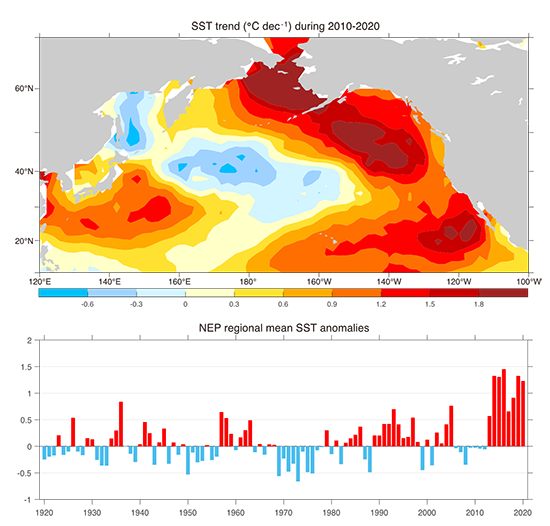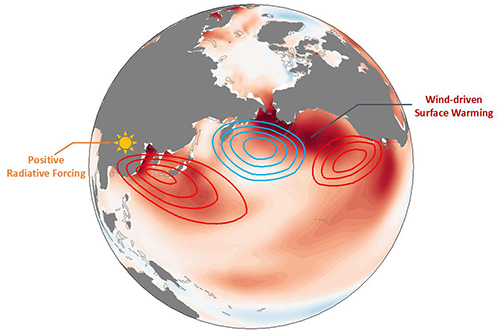The team led by Prof. Zheng Xiaotong and Associate Prof. Wang Hai of the College of Oceanic and Atmospheric Sciences and Frontiers Science Center for Deep Ocean Multispheres and Earth System from OUC, together with scholars from home and abroad, made significant progress in the climate effects of anthropogenic aerosol. For the first time, the research revealed the causes of the anomalous and rapid warming of SSTs in the Northeast Pacific Ocean in recent years from the viewpoint of the remote correlation of atmospheric changes caused by changes in anthropogenic aerosol emissions. The research outcome entitled “Atmosphere teleconnections from abatement of China aerosol emissions exacerbate Northeast Pacific warm blob events” was published in Proceedings of the National Academy of Sciences of the United States of America. Science.
The Northeast Pacific Ocean has experienced a number of record-breaking extreme warm sea surface temperature (SST) events (also known as warm spots or oceanic heat waves) since 2010. These events have important implications for marine ecosystems as well as weather and climate anomalies in the surrounding region. Studies have shown that the SST in the Northeast Pacific Ocean has been mainly characterized by interannual variability over the past 100 years, and has not responded significantly to global warming caused by greenhouse gas forcing. However, since 2010, the warming of the SST in the Northeast Pacific has shown a significant acceleration, which has led to a number of extreme warm anomalies. Most of the existing studies attribute this phenomenon to the natural variability of the climate system or global warming, but they do not explain the recent sudden acceleration of SST warming in the Northeast Pacific.


The research shows that anthropogenic aerosols’ rapid reduction of emission in China reverses the trend of increasing aerosol emissions in the past years, and the effect on the long-term warming of the SST of the Northeast Pacific Ocean changes from suppression to intensification, which jointly causes the acceleration of the SST warming in the Northeast Pacific Ocean through the synergistic warming effect of greenhouse gas forcing. It is found that China’s anthropogenic aerosol abatement leads to anomalous warming of the local atmospheric troposphere and excites an atmospheric remotely correlated wave train over the Northeast Pacific from East Asia to the Northeast Pacific, which strengthens and moves southward the Aleutian Low. The anomalous atmospheric circulation changes lead to a significant warming of the SST in the Northeast Pacific by weakening the surface winds, which provide favorable preconditions for the occurrence of the warm spot events.
With different single forcing scenarios, further study finds that GHG forcing leads to a sustained warming of SST in the Northeast Pacific, while changes in anthropogenic aerosol emissions slow down and intensify the magnitude of warming around 2010, respectively. This suggests that, unlike the long-term warming effect of greenhouse gas forcing, the impact of anthropogenic aerosol forcing on the rate of ocean warming is mainly reflected in the interdecadal adjustment. Therefore, to mitigate the long-term warming of the oceans and the disasters it brings, the reduction of greenhouse gas emissions is the fundamental solution, while the change of anthropogenic aerosol emissions is one of the important factors to be taken into account for accurate prediction and response. The research reveals the large-scale climate effect of anthropogenic aerosol emission changes, which provides a new perspective for understanding the impact of human activities on the ocean, and at the same time provides an important theoretical basis for the prediction of future climate change.